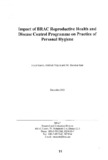| dc.contributor.author | Karim, Fazlul | |
| dc.contributor.author | Tripura, Abhilash | |
| dc.contributor.author | Gani, Md. Showkat | |
| dc.date.accessioned | 2019-11-20T05:27:14Z | |
| dc.date.available | 2019-11-20T05:27:14Z | |
| dc.date.issued | 2001-12 | |
| dc.identifier.citation | Karim, F., Tripura, A., & Gani, M. S. (2001, December). Impact of BRAC reproductive health and disease control programme on practice of personal hygiene. Research Reports (2001): Health Studies, Vol - XXX, 91–110. | en_US |
| dc.identifier.uri | http://hdl.handle.net/10361/13025 | |
| dc.description.abstract | The campaign on safe water, sanitation and hygiene practices has been an important
priority in BRAC's health interventions including RHDC. The RHDC hygiene education
is concerned with establishing or inducing changes in personal and group attitudes and
behaviour that promote healthy living. Given the situation, one may ask about the
achievements of RHDC in improving the sanitation and hygiene practice.
Thus, this study evaluated the impact of BRAC's RHDC programme on different
issues of personal hygiene compared to baseline status as well as the comparison area. In
the baseline study (1992) fertility and morality data were collected from 12,073
households (programme 8,072 and comparison 4,001) representing a total of 261 villages
(programme 184 and comparison 77). But, in the follow-up study done in 2000, 103
vi II ages (programme 80 and comparison 23) were revisited. Using the cluster survey
method, data were collected from 8,033 households (programme 4,003 and comparison
4,030). The programme vilbges were drawn from Bogra and Dinajpur districts whilst the
comparison villages from Jaipurhat district. It is to be noted that for measuring the level
of different health service use and hygienic practices, data were collected from IQI'';(. and
25% on the total households covered for mortality and estimate during the
baseline and the follow-up studies respective! y, because measurement of these issues
required lesser number of sample than the mortality and fertility estimates. However, the
following sections present the key findings of the study. | en_US |
| dc.language.iso | en | en_US |
| dc.publisher | BRAC Research and Evaluation Division (RED) | en_US |
| dc.subject | BRAC | en_US |
| dc.subject | Reproductive health | en_US |
| dc.subject | Reproductive Health and Disease Control (RHDC) | en_US |
| dc.subject | Disease control programme | en_US |
| dc.subject | Personal hygiene | en_US |
| dc.subject.lcsh | Health surveys -- Bangladesh. | |
| dc.subject.lcsh | Health, Nutrition, and Population Program (BRAC) | |
| dc.subject.lcsh | Hygiene | |
| dc.title | Impact of BRAC reproductive health and disease control programme on practice of personal hygiene | en_US |
| dc.type | Research report | en_US |

